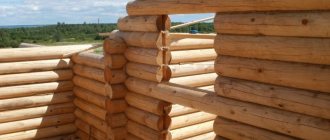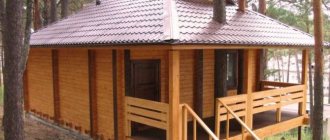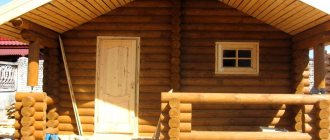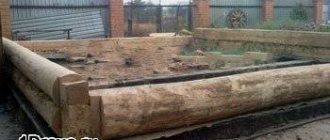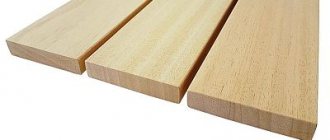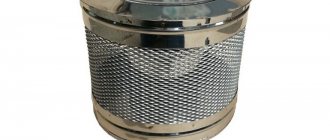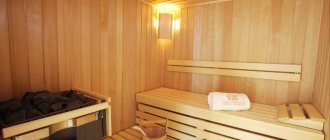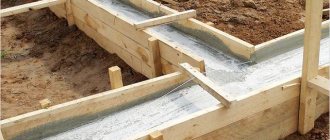Our great-grandfathers built bathhouses from logs. Modern logs are processed on a machine and acquire an attractive appearance. Baths continue to be built from simple logs, time-tested and rounded. Both options are suitable and have their advantages. But what diameter of log is needed for a bathhouse? How not to make mistakes and choose the right material? Will the walls freeze in winter if a small section is used? We'll talk about all this in more detail below.
The log for the bathhouse is selected with the correct diameter so that the walls do not freeze and retain heat well.
Choosing a log type
Currently, the following types of lumber can be used for the construction of log houses:
- A simple sanded log, the structures from which have a traditional appearance. The main advantage of the material is the protection of the core due to the preservation of the top layer.
- The planed log has a beautiful texture and light shade due to processing with hand planes. It is expensive and requires the use of protective compounds.
- A rounded log, thanks to the use of special equipment in production, has a smooth surface and the same diameter along its entire length. The disadvantages are similar to those of planed lumber.
- Square beams have an affordable price. Structures made from it have smooth, even walls. The disadvantage is the complexity of assembly, requiring adjustment of each element on the construction site.
Advice! Regardless of the type of lumber chosen, it must be treated with special compounds to increase the durability and aesthetic appeal of the structure.
What is a log house?
A log house is a structure made of crowns of logs, stacked one on top of the other and secured at the corners into grooves. Each log is adjusted to each other to create an even structure. Wooden saunas are very popular; many people love the unique aroma of wood when heated. Tannins are beneficial for the body.
The walls of a log bathhouse warm up faster, they “breathe” and absorb moisture well. The connections of chopped log crowns can be insulated with jute tape, linen tow, felt or moss.
wooden log house
It is necessary to install a shallow strip foundation. There is also an option for screw piles. To protect the log from getting wet, foundation ventilation is required. To do this, vents are placed on all sides, and in the cold season they are closed. Don't skimp on roof overhangs. The higher the building, the longer the overhangs are needed.
The distance between the building and other buildings is specified in regulations. Compliance with the rules is verified by government agencies. There are distance standards that apply only to baths, regardless of their materials. A log bathhouse must be treated with a fire retardant and antiseptic. Each time after using the bath, it must be ventilated.
What influences the choice of log diameter?
As a standard, lumber with a size of 20-36 cm is selected for baths. Rounded logs have a 1 cm smaller diameter than unprocessed logs, which are measured together with the bark.
Factors taken into account when choosing lumber:
- Air temperature in the region in winter;
- Frequency of use of the bath;
- Log size;
- Drying technology.
Advice! For construction in central Russia, it is advisable to choose coniferous trees grown in the northern regions. This material has greater density and less moisture absorption, which, accordingly, increases the service life of the structure.
Dependence on winter temperature in the region:
| Maximum temperature in winter | Recommended log diameter, cm |
| Below -30°C | 26-36 |
| Up to -15°С | 20-25 |
*For the middle strip, the cross-section should be within 22-30 cm.
For a one-story bathhouse on a summer cottage, used exclusively in summer, logs with a diameter of 18-20 cm are sufficient. The construction does not require the construction of a powerful foundation and can be erected with one’s own hands. Such a building warms up quickly, but retains heat for a short time.
A bathhouse for year-round use is built from logs with a diameter of at least 24 cm. The foundation requires a monolithic or massive strip foundation.
Important! When using large-diameter lumber for construction, it is necessary to involve assistants or special equipment.
It is more difficult to warm up a two-story bathhouse or a building with an attic, so to reduce heat loss and increase the load-bearing capacity of the walls, they are built from logs with a diameter of at least 25 cm.
Wood drying technology affects its moisture content, which determines the degree of shrinkage of the structure, which is:
- Lumber of natural moisture, obtained by hand cutting - at least 15 cm;
- Winter forest and natural drying - no less than 4-6 cm;
- Rounded chamber-drying log - 3 cm.
This parameter must be taken into account when designing the height of the building and calculating the amount of wood required.
Conclusion
Now you know how to choose the optimal diameter of a log for permanent residence, so that you feel cozy and comfortable in your home. But I would like to remind you that the building has many places that are sources of heat loss, even if you choose a log house of the required size. These elements include door and window openings, because a lot depends on the quality of the product!
In order for the house to be warm, you need to take into account a lot of specific points at the design stage: floor, walls, ceilings, basement (if any), openings
In the video presented in this article you will find additional information on this topic.
Tips for purchasing and harvesting lumber
Logs must be free from insects and mechanical damage. You should choose straight trunks without curvature that have the smallest discrepancy in the diameters of the ends - up to 3 cm. For lumber longer than 3 meters, a permissible deviation of 1 cm per 1 linear meter is accepted.
Important! The complexity of the work, as well as the cost of the log house, is directly proportional to the thickness of the logs - the thicker it is, the more difficult it is to carry out construction and the more expensive it will cost.
Self-harvesting logs:
- Self-cutting of forests is carried out in winter, when the wood has a moisture content of up to 10-12% - this ensures minimal shrinkage of the building and makes it possible to use material with a smaller cross-section.
- When choosing trunks, 1 cm is added to the calculated diameter of the logs for subsequent processing.
- When using an electric or chainsaw, it must be taken into account that after using these tools, the treated surface becomes significantly tousled, as a result of which it is more susceptible to rotting. To prevent this, craftsmen recommend not to reach the marking of 5-10 mm, to cut down the wood between pre-made cross-cuts and to do the finishing hew with an axe.
- For construction, freshly cut logs are used, which are easier to process. After drying in a laid frame, such wood is less deformed and cracks.
- After removing the bark, the lumber is stacked, placing bars between the layers to organize air circulation. The logs are stored under a canopy or covered with moisture-proof material, which also protects from direct sunlight. Drying lasts two weeks, after which the felling of the log house begins. Overdried wood is difficult to process.
- To reduce cracking of logs on the facades, notches are made in each of them on the side opposite to the longitudinal groove. Their depth should be up to ¼ of the diameter of the lumber. These cuts are designed to compensate for internal stresses arising during the processes of wetting and drying under the influence of atmospheric factors, and, as a result, to prevent the occurrence of cracks.
Proper selection and harvesting of timber for construction allows you to obtain a durable, warm and aesthetically attractive bathhouse.
Choosing a wood species
Answering the question: how to choose a log house for a bathhouse, it should be noted that the log house is made of coniferous or deciduous wood.
Conifers
Baths are made from logs of grades 1 and 2, these can be:
- Fir,
- Spruce,
- Pine logs.
Their average thickness is from 14 to 24 centimeters, and their length is from 3 to 6.5 meters. It is important to know that log houses are not made from cedar, since this type of wood emits harmful substances when heated.
coniferous log house for a bath
Using pine and spruce, the lower crowns are often made from harder larch. It also goes under the rafters and floor.
Spruce perfectly removes excess moisture, while pine allows air to pass through better. There is no difference in durability. A larch frame will cost more because it requires more effort when processing. At the same time, the walls will be heavier and a little colder. The level of fire resistance of larch is greater than that of pine and spruce. The core of the larch trunk is moisture-resistant and durable.
Hardwood
Type 2 logs are suitable for deciduous wood logs. Their thickness can vary from 12 to 24 centimeters, and their length from 4 to 6.5 meters. The design can be complicated by internal partitions. The bathhouse can be made from the trunks of birch, linden, maple, poplar, aspen, beech, and hornbeam.
Linden bath
You can use oak for the floor joists and crown molding. Aspen is often used for log houses; it is moisture-resistant, resistant to pests and fires, and has a low cost. After sanding, the aspen looks great, the steam in an aspen bath is softer and more pleasant. But a bathhouse made of such wood does not allow moisture to pass through well; the room must be regularly ventilated.
Linden is similar to aspen in terms of its level of softness and its numerous irregularities. But it should be noted that linden is prone to rotting. You can make the top crowns or just the shelves linden. They won't get very hot. Birch is harder than linden and aspen, it is less susceptible to rotting. Birch warms up better than linden.
Advantages and disadvantages
Any wooden house is good for its light weight and environmental friendliness. A log building has its own characteristics. In what ways is a log inferior to timber?
- The log is less technologically advanced, the stand made from it is more difficult and slower;
- When such a bathhouse (log house) is built, the layout is adjusted to the length of the log;
- At the junction of the crowns, the thickness of the wall is equal to the width of the groove and, accordingly, approximately half the diameter of the log. This negatively affects heat retention in the room.;
Advantages of a log house for a bath:
- The closed joints of the crowns and the external appearance of the log house make it possible to refuse cladding;
- A log, unlike timber, does not have through cracks through the middle.
How to choose the right logs for a log house?
It is worth knowing that in winter the trees “sleep” and there is no sap flow in them. Wood from winter trees is strong and dry. In the summer, the trees are filled with sap, so the logs often crack when they dry out. Every crack opens the way for rot, moisture and insects.
Log sellers are well aware of these nuances. When people buy a log house in the summer, sellers try to prove that it is from “winter” trees. More often than not, this is not the case. Wood storage is too expensive. If we are really talking about a “winter” forest, then the logs can be stored in the open air, which destroys all the advantages of such wood. The conclusion is simple: you can choose good logs, but you need to do it in winter. The best time to buy a log house is from late October to March.
The quality of the log is also affected by where the trees grow. Strong and dense products are obtained from trees that grow at higher elevations and in sandy soil. If the trees grew in a swampy or low-lying area, the wood will be of lower quality. It is loose and “watery”.
Log houses are often sold in sets. This includes windows, ceilings, doors and other structures. On the one hand, this is convenient, since everything fits together. But on the other hand, the kits may be too overpriced.
It is worth noting that it is better to purchase a log house directly from the manufacturer. It is always better to avoid intermediaries. Unfortunately, there are too many of them on the market. By using the services of intermediaries, you greatly overpay. The cost of the log house includes the seller’s salary, advertising costs, etc.
It is more profitable to buy a log house without additional goods. Often low-quality lumber, made from a different type of wood, is sold together with a log house. When ordering a log house, you should ask the seller what is included in the basic kit.
Which is better
Log buildings vary in total area and number of floors. For a bathhouse, they often prefer a small one-story log house with a terrace, the area of one floor is 30–50 m2.
Logs for log houses can be hewn (planed) or galvanized (with the outer layer cut to a given diameter).
How a rounded log is inferior to a hewn log:
- cracks appear earlier and larger;
- the log house looks unnatural;
- processing technology removes the densest sapwood;
- wood quality indicators visible on the outer layer are hidden;
- processing technique - with a miter saw, a milling cutter - makes the wood more vulnerable, the log rots and collapses more quickly (an ax and a plane do not saw, but chop, not “shaggy”, but flattening the fibers);
- requires more impregnation consumption;
The main advantage of logs that have gone through a rounding machine is the speed and ease of erecting walls.
Semicircular joints of the same width are not blown through and make the wall more stable.
As a result, the owner receives a beautiful log bathhouse, which does not require additional wall cladding.
But the performance qualities of a log house are much higher if the cambium of individual logs is manually trimmed (the layer immediately under the bark, hygroscopic and attractive to bugs).
In this case, only 1-2 annual rings of the sapwood (the layer between the core and the cambium) should be captured, and the surface should be well sanded.
Information. The plane removes too thick a layer of wood. A scraper is a more gentle tool designed specifically for this operation.
How to choose material
The properties of wood are influenced not only by the type of tree, but also by the place where it grows.
The point is the intensity of growth of the trunk and annual rings. The harsher the conditions, the denser the wood.
There is an opinion that it is better to use wood for construction in the same area where it grew.
Although traditionally, log bathhouses from the northern forest, for example, from the Arkhangelsk region, are in high demand.
Is it important to harvest timber in winter? Will the “winter” log house sag more weakly and last longer?
In fact, it turns out that the properties of wood do not change with the time of felling.
Logging during the nesting period of birds is prohibited. An autumn log house subsequently has fewer deep cracks, since the first stage of drying occurs during the cold season.
The thinner the growth rings of a log, the better. Thick rings indicate favorable growth conditions for the tree, which means that the wood is not “hardened.”
Attention! If the thickness of the growth rings of logs is different from different sides, then it is better to turn the narrower rings towards the outside of the building.
When choosing unprepared logs for a log house, it is better to consult a carpenter rather than a seller.

